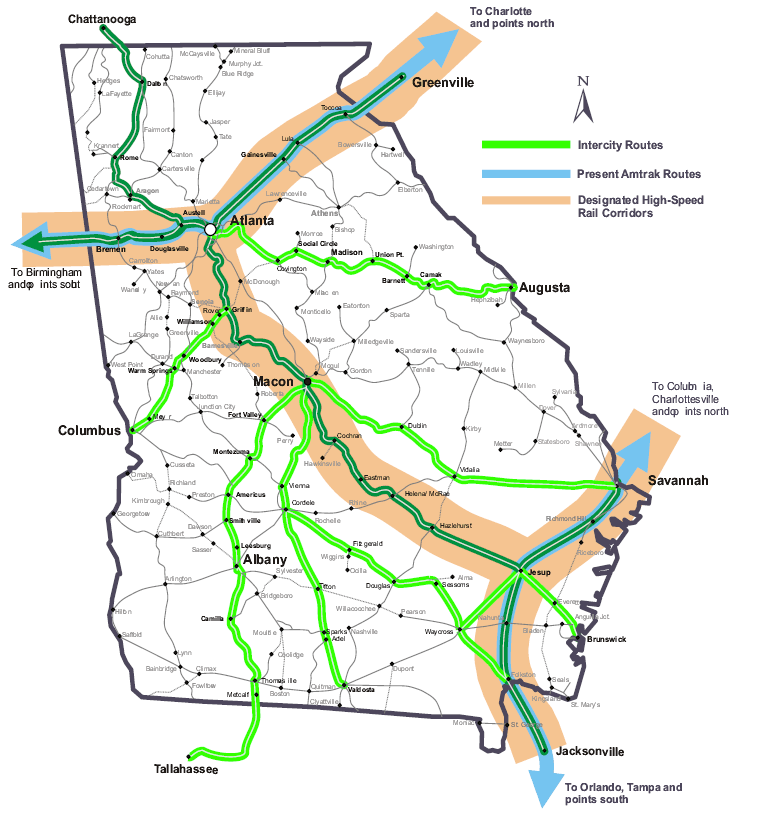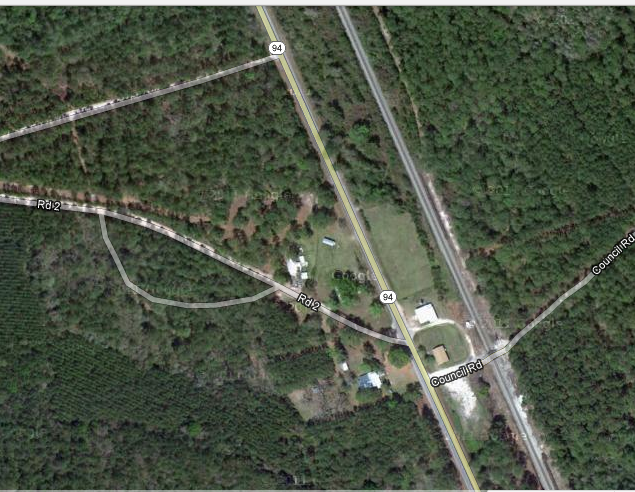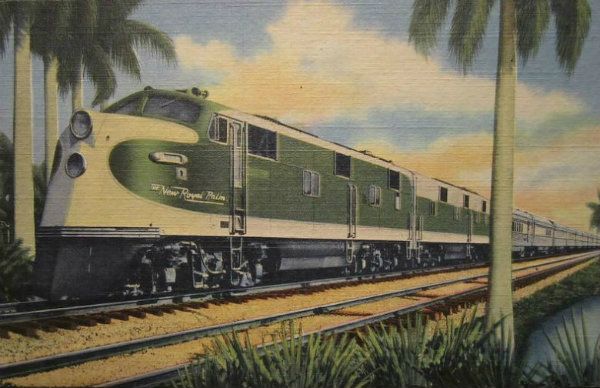In 1892 the Central of Georgia bought compound #1592 from Baldwin Locomotive Works and named the locomotive “Nancy Hanks†after the mare that held the world mile trotting record at the time, the mare herself was said to have been named after Abraham Lincoln’s mother. The following year the locomotive was assigned to a speedy Savannah – Atlanta passenger train, and soon the moniker migrated from the locomotive to the entire train, which sported blue and gold coaches, with each bearing a likeness to the renowned mare. Service was cancelled, however, on August 13, 1893, after several “Nancys†trotted off the tracks, which at the time was unprepared for the speeds the Compound could make when she stretched out her long legs.
Fifty four years later on July 17, 1947, Central's quick footed coast-to-capitol service returned, this time to much more capable trackage, in the form of a beautiful blue and gray four-car diesel powered streamliner, the Nancy Hanks II. The cars were from American Car and Foundry, the power from General Motors, and the service was an immediate success. Central applied the same sound philosophy to the Nancy Hanks II that it applied to the Man O' War - cheap fares and a ninety-notches-and-no-smoke schedule in combination to draw Georgians out of their ever more beloved automobiles.
There were twelve schedule stops and three flag stops between the Savannah Passenger Depot and Atlanta Terminal Station. Only five minutes were allowed for the stop in Macon, and the 293.7-mile route was covered in 5 hours and 40 minutes on the Savannah-Atlanta run. A grill-lounge car provided "all meals."
Ridership was high, and the Central quickly found its decision to tack six extra general service coaches onto the ACF "Nancy" order had been wisely made. A fifth car was added to the Nancy Hanks II on weekdays and a sixth on weekends. Like a seasoned jockey the Central whipped up patronage with promotions like "Rich's Shoppers Specials" on both the "Nancy" and the Man O' War, bringing travelers practically to the doorsteps of the resplendent Department Store of the South in downtown Atlanta, quite an adventure in Georgia in the days before shopping malls in every hamlet.
Sadly, by the time the Southern bought the Central on 1963 the "handwriting was on the wall" for the Nancy Hanks II, to quote President Dillard. Airlines were no longer just exotic luxuries for the wealthy and every year a bridge replaced one more ferry and a few more red clay hills were cut down and smoothed over by a ribbon of asphalt. Georgians could drive their own automobiles to Rich's, even after a rainy spell.
In 1968 the Southern gamely added dome cars purchased from the Wabash to the "Nancy" in an effort to boost patronage, but by now there was a good deal more handwriting than wall. By 1970 Southern wanted out and sought to discontinue the Nancy Hanks II, but the Georgia Public Service Commission ordered the Southern to keep the train running.
However, Southern saw a way to rid itself of the Nancy Hanks II, in spite of the Georgia PSC. The law that created Amtrak stated that when a railroad joined Amtrak that railroad could terminate its passenger service. In 1971, Southern Railway had declined to join Amtrak, in part so that it could continue to operate the Crescent. However, in a highly unusual move, Southern claimed that subsidiary Central of Georgia was technically an independent railroad, and as such able to join Amtrak, even while parent Southern stayed out.
Amtrak agreed with Southern's interpretation of the legislation and admitted the Central of Georgia, which, according to the wishes of its parent, then exercised its option to drop the Nancy Hanks II. The National Association of Rail Passengers sued both Amtrak and Southern, seeking to have the decision overturned, pointing out that the Central was merely an operating division of the Southern. The courts, however, sided with Southern and the Nancy Hanks II was doomed. Old friends could only stand and watch when, on April 30, 1971, the "Nancy" pulled out of Savannah for the last time.
Certainly the Nancy Hanks III should be reestablished on a daily Atlanta-Savannah Route. The sister train of the Nancy Hanks II could easily be reestablished between Atlanta and Columbus. Jacksonville however, is a different story.

This is a map from an older plan, but it shows the lines.
I wonder what effect it would have on the process if we launched a full court press, developed an organization, and stacked it with political converts, one at a time, to get some logic in this plan.
Two famous routes connect Jacksonville and Atlanta, the same length almost to the mile, neither of them passing through Savannah. Another possible route would run over the tracks of two railroads, CSX from Jacksonville to Jesup, and NS from Jesup to Atlanta.
NS is usually easier to work with the CSX on projects involving the public, and I-75 is by far the heaviest trafficked route between northern states and Southern states. The Norfolk Southern, nee Southern Railway, nee Georgia, Southern and Florida, is in my opinion the superior line. Nearly arrow straight from Jacksonville to Valdosta (a sizable community in it's own right) then on to Macon-Atlanta-Chattanooga, this is the route of the former flagship trains, 'The Ponce De Leon,' and 'The Royal Palm.'

Greater Metropolitan Council, Georgia
If you think the dirty tricks involving The Nancy Hanks II were bad, you'd love the final days of these trains. Southern wanting out of the passenger business discovered a loophole in the law permitting ending passenger service virtually without notice if certain conditions were met pertaining to flagging ridership.
The Ponce De Leon's ridership fell to just the right ratio between Council, Georgia and Jacksonville, Florida. (Council, is south of the Okefenokee Swamp about half way between Jacksonville and Valdosta). So one day in February 1964, the Ponce De Leon rolled out of Cincinnati, Chattanooga, Atlanta, Macon and Valdosta and came to a halt in Council. Buses would move the passengers on country highways the rest of the way into Jacksonville. Apparently there isn't much of a market for passenger trains, buses or aircraft between the midwest cities and Council, so just like that, the Ponce De Leon was dead.
Then there was the slow dismemberment of the sister train to the Ponce De Leon, known as The Royal Palm. The amenities provided on the Royal Palm were gradually curtailed as Southern Railway attempted to reduce operating losses. The train was discontinued in segments - first between Jacksonville and Valdosta, Georgia in 1966 when the diner and sleeper were dropped - but the Palm carried its coach-lounge right up to the end of its long career. Ironically, the "Royal Palm" name was kept even though the train no longer served Florida where royal palms thrived on the lower east coast. Later the two-car remnant of the once proud sunliner was discontinued south of Atlanta, then the section between Somerset, Kentucky and Dalton, Georgia was cut, leaving two disconnected trains, which were finally discontinued in 1970.
 THIS IS WHERE GEORGIA, FLORIDA AND JACKSONVILLE, SHOULD BE LOOKING TO REESTABLISH SERVICE BETWEEN FLORIDA AND THE MIDWEST
THIS IS WHERE GEORGIA, FLORIDA AND JACKSONVILLE, SHOULD BE LOOKING TO REESTABLISH SERVICE BETWEEN FLORIDA AND THE MIDWEST.
